Compression Therapy
Compression Therapy
Historically venous leg ulcers are managed with compression therapy. Compression therapy has been one of the earliest treatments known to medicine dating back as early as the Neolithic period (5000-2500 BC). Compression therapy has evolved from rudimentary bandaging to more sophisticated systems and remains the gold standard for the management of venous leg ulcers. Although the basic principles of compression remain the same; there are new approaches to management that may offer enhanced and promising healing outcomes. A 2021 Cochrane Review (Shi et. al) searched the most recent RCT’s to determine if compression therapies (short-stretch inelastic bandage, four-layer elastic compression bandage, and Unna’s [zinc oxide] boot) versus no compression (usual care) improved wound healing outcomes. The evidence suggests that:
- people wearing compression bandages or stockings probably experience complete ulcer healing more quickly
- more people treated using the compression bandages or stockings are likely to experience complete ulcer healing within 12 months.
However, we did not find clear evidence to tell if using compression bandages or stockings causes any unwanted effects.
Compression therapy choices are based on:
- Strength of the compression (measured in mmHg especially for elastic systems)
- Type of compression (short stretch inelastic or long stretch elastic stretch)
- Size and shape of the limb
- Skill of the clinician
- Frequency of required dressing changes (re-useable options for frequent changes)
- Patient centered issues (pain is often greater with elastic systems with high pressure at rest)
- Self management options –Velcro wraps or compression hosiery, tubular stockinette options)
Wounds Canada offers clinicians the Product Picker for VLU’s
When applying compression, it is important to start at the base of the toes and continue up the leg to include the heel and up to two finger widths below the popliteal fossa (posterior knee). The following photos demonstrate both correct and incorrect application of compression therapy.
Photo showing the correct application of compression bandage start at the base of the toes and continue up the leg to include the heel and up to two finger widths below the popliteal fossa
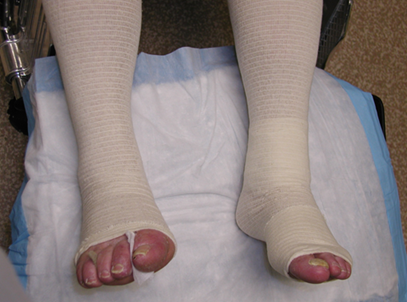
Photo showing incorrect application of compression bandage where it was not started at the base of the toes and only to mid calf, not to 2 fingers below the posterior knee
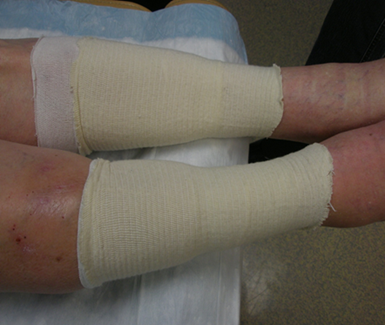
Photo showing incorrect application of compression bandage where the heel is prominently exposed
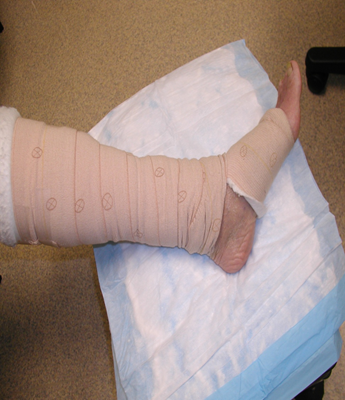
It is important to rule out arterial disease. Photo showing signs of vascular compromise (areas of necrosis [black])
![Photo showing signs of vascular compromise (areas of necrosis [black])](https://ecampusontario.pressbooks.pub/app/uploads/sites/2095/2022/01/VascularCompromise.png)
With the application of any compression system, it is important to follow the manufacturer’s guidelines. Some manufacturers suggest that the compression system can be worn up to seven days. Caution should be noted when initiating compression as there will be a high level of exudate for the first few days and therefore, the dressings should be changed more frequently to prevent maceration.
See picture below that demonstrates signs of maceration.
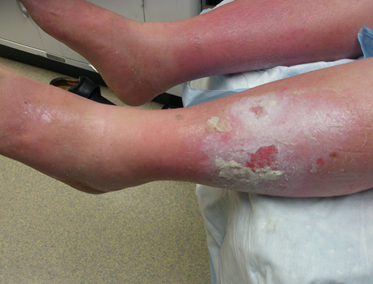
With the first application of a compression device [Multilayer Compression System-MCS, Tubular PS or compression bandage (CB)], patients often report that the compression feels ‘too tight’. This may influence adherence. It may take several days before patients are accustomed to wearing compression. This compression-related discomfort is usually experienced around the ankle or foot. Discomfort or pain below compression may be due to the new experience of the ‘pressure on the leg’ but may also be due to incorrect sizing (Rabe et al., 2020), infection, edema, fluid mobilization or inflamed venous disease.
Forefoot edema and edema above the compression system can occur, particularly in patients with lymphedema. In this patient population, forefoot edema can lead to possible fungal and secondary bacterial infections between the toes. Risk of skin damage and further misshaping of the limb due to bandage slippage are common issues that are encountered (Green, 2020).
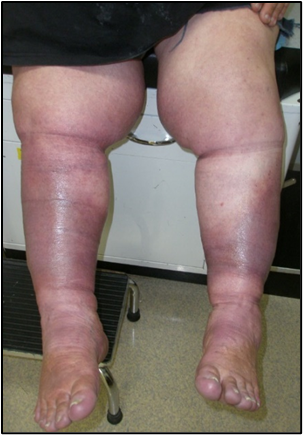
Photo showing misshaping of legs due to long term incorrect application of compression bandages.
Initially, if patients are unable to tolerate a high-level compression therapy, start with a lower-level compression therapy to move some of the fluid and gradually increase the pressure as tolerated.
Recurrence rates of venous ulcers have been reported as high as 70%. Compression therapy is a life-long commitment that requires daily wear to prevent venous leg ulcer recurrence. When determining the appropriate compression/hosiery for each patient the following should be considered (Evans et al., 2019):
- Affordability
- Comfort
- Ease of application
- Non-allergenic
- Able to fit into the patient’s shoes

